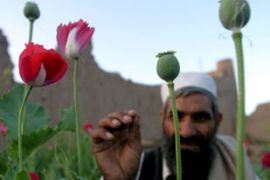UN: World drug problem stabilising
Dramatic cut in production in southeast Asia offset by huge rises in Afghanistan.

Poppy cultivation, which can be used to produce heroin, morphine and opium, has fallen by about 80 per cent since 2000 in the Golden Triangle, which includes parts of Laos, Myanmar and Thailand.
But despite the dramatic fall in southeast Asia, opium production reached a record 6,610 tonnes worldwide last year, up 43 per cent from 2005.
Afghanistan expansion
This was due to a near 50 per cent increase in production in Afghanistan.
| External link |
|
|
The area under opium poppy cultivation in the country also expanded, from 1,040 sq km in 2005, to 1,650 sq km in 2006 – an increase of about 59 per cent.
“This is the largest area under opium poppy cultivation ever recorded in Afghanistan,” the report said, noting that 62 per cent of the cultivation was concentrated in the country’s southern region.
“For no other drug is production so concentrated in a single area.”
Costa said Helmand province was becoming the world’s biggest drug supplier, with illicit cultivation there larger than in the rest of the country put together.
‘Drug cancer’
“Effective surgery on Helmand’s drug and insurgency cancer will rid the world of the most dangerous source of its most dangerous narcotic and go a long way to bringing security to the region,” Costa said in a statement.
Income from the industry in Afghanistan is more than $3bn annually.
Sophisticated laboratories inside Afghanistan are now converting 90 per cent of their opium into heroin and morphine before smuggling it around the world, UNODC officials said before the report’s release. Until two years ago, Afghanistan exported the drug almost exclusively in its raw form.
The area used for coca cultivation – the raw material for producing cocaine – dropped by 29 per cent between 2000 and 2006, and by 52 per cent in Colombia alone.
But, although cultivation dropped last year, as much cocaine was produced worldwide as in 2005, “apparently due to improvements in coca cultivation and cocaine production technology,” the report said.
Cocaine consumption
It also noted that while cocaine demand was decreasing in North America, “consumption increased significantly in Europe, doubling or tripling in several countries over the last decade”.
 |
| Colombia has cut the area being used for coca cultivation by 52 per cent [EPA] |
The report expressed concerns about the situation in Africa, suggesting it could find itself at the crossroads of international drug crime.
“There are warning signs that Africa is also under attack, targeted by cocaine traffickers from the west – Colombia – and heroin smugglers in the east – Afghanistan,” it said.
“This threat needs to be addressed quickly to stamp out drug-related crime, money-laundering and corruption, and to prevent the spread of drug use that could cause havoc across a continent already plagued by other tragedies.”
Cannabis, or marijuana, remained the most widely used drug. Of the 200 million people (aged 15-64) who are drug-users, about 160 million take cannabis, the report said.
But Costa remained positive, noting that “for the first time in years, we do not see an upward trend in the global production and consumption of cannabis”.
Al Jazeera is not responsible for the content of external websites.
